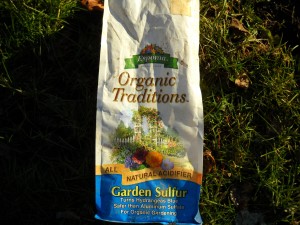Tending Your Soils, Now!
I have a confession to make: I added soil amendments last week without first getting my soil tested. I teach gardening, and the first thing I say about soil is it to get it tested before you do anything. But winter is coming, and I have a good idea what a soil test would tell me. So I added some limestone to my lawn around an aging maple tree, and I added sulfur around my blueberries.
Here’s what my thoughts were: I know that the acid rain we have leaches out calcium from the soil. Maple trees, in particular, suffer if they don’t have enough calcium, so I added some. I used a 28-oz can, spreading 6 containers of agricultural limestone in a circle with a radius of 25 feet around the tree.
I know that blueberries like very acid soil, and that adding some sulfur is a good thing, especially since I haven’t done so in a couple of years. Blueberries perform best when the soil is between pH 4.5 and 5.5, and my soil is probably about pH 6.0. In a 6-foot diameter circle around each bush I sprinkled 1 pound of garden sulfur, which should help.
I recently spoke to soil scientist Dr. Wendy-Sue Harper of Monkton, Vermont to see what she recommended we do at this time of year. Her strongest recommendation was to make sure we cover up any bare soil with leaves, straw or mulch hay. She said that if you have cleaned up the vegetable garden and bare soil is exposed, it’s likely that some of your all-important top soil will wash or blow away before next spring. Gardens on any slope are especially vulnerable to erosion.
Some gardeners take soils for granted. They spread some 10-10-10 fertilizer on the soil in the spring or water with a liquid chemical fertilizer in summer, and they get tomatoes and carrots. But I recommend compost and organic fertilizers because they nourish the beneficial organisms in the soil. In preparing for this article I read a book on soils called, Teaming with Microbes: The Organic Gardener’s Guide to the Soil food Web by Jeff Lowenfels and Wayne Lewis. The book, which is highly technical, makes the point that good soil is chock-full of living organisms, millions in a teaspoon, and that any chemical, including chemical fertilizers, reduce the numbers of living organisms in the soil.
The authors explain that chemical fertilizers are salts. You probably know what happens if you sprinkle salt on a slug. It dies. The same happens to your beneficial microbes when you add chemical fertilizers.
Lowenfels and Lewis explain that the microbes in your soil contain not only nitrogen, phosphorus, potassium (the contents of chemical fertilizer) but also all the micronutrients needed by plants but not found in chemical fertilizer. Bacteria, fungi and other microbes hold onto nutrients in their bodies, only releasing them when they die or are eaten by other organisms. The chemical nutrients in these microbes are in a form that can be absorbed easily by roots of plants when released in the soil.
The area right around the roots of your plants is especially full of microbes. Why? Because plants roots give off excess sugars. Plants produce extra sugars by photosynthesis during the day, and exude sugars at night. That may sound crazy, but it isn’t: plants and microbes in a healthy organic soil share nutrients, helping each other. Plants benefit by having fungi surrounding their roots because fungi hold water and minerals that they share with the plants; fungi benefit by getting food from the plants. It’s a win-win situation.
Fungi produce acids and enzymes that can dissolve minerals that plants cannot ingest. The tip of a fungal hypha (rootlet, if you will) can also breakdown cellulose and lignin, tough materials that contain useful ingredients for plant growth – recycling the nutrients.
As I explained in my book, The Vermont Gardener’s Companion, sandy soils have large particles and don’t hold onto water and minerals easily. Think of sandy soil as golf balls in a wire basket. Water flows right through. Add compost – like adding sponges to the basket of golf balls- and water and nutrients are retained.
Clay soils are more like a bowl of baker’s flour: fine particles that don’t let water pass through easily, and are sticky when wet. Loam is what we want: a mixture of particle sizes that allows water through, but retains water and minerals. Whether you have a clay soil or a sandy soil, the easiest way to get that fluffy, loose loam is to add compost.
Compost adds organic matter to feed the microbes in your soil, attracts beneficial earthworms, and improves drainage. You don’t want to be digging in your garden at this time of year, but you can spread some compost on the soil surface around perennials, shrubs, on the lawn and in the vegetable garden. Don’t walk in your beds now; they are wet and easily compacted, injuring soil structure.
So get your soil tested now, before the ground freezes solid. Come spring it takes 3 weeks or more to get test results from a soil test, as that’s when everyone else wants a test done, too. I recommend getting multiple soil tests: one for the vegetable garden, one for the flower beds, and from specialty locations like the lawn or blueberry patch. Contact your local University Extension Service, or go online.
Henry Homeyer is the author of 4 gardening books. He can be reached at henry.homeyer@comcast.net. His Web site is www.Gardening-Guy.com.



